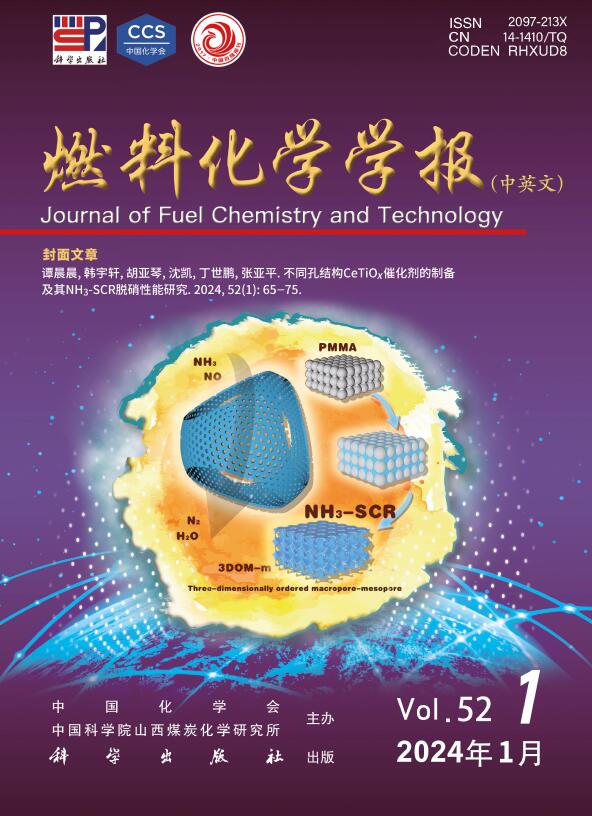Hydrodesulfurization of dibenzothiophene over NiMoP/Al2O3 bimetallic phosphide catalyst
Q3 Energy
引用次数: 0
Abstract
Preparation of highly active hydrodesulfurization catalysts is extremely meaningful for the sulfur removal from thiophene substances. In this work, commercial nano-Al2O3 with mesoporous structure supported monometallic phosphide (NiP/Al2O3 and MoP/Al2O3) and bimetallic phosphide (NiMoP/Al2O3 with various Ni/Mo molar ratio) catalysts are successfully prepared by temperature-programmed reduction. X-ray diffraction (XRD) result shows the Ni/Mo molar ratio affect the crystal phase in catalysts. Scanning electron microscopy (SEM), transmission electron microscopy (TEM) and X-ray photoelectron spectroscopy (XPS) characterizations co-confirm the interact between Ni and Mo elements in bimetallic phosphide. Catalyst evaluation in hydrodesulfurization of dibenzothiophene shows that bimetallic phosphide samples exhibit better catalytic performance than monometallic phosphide. 62.1% conversion and 86.3% biphenyl selectivity with 30 h stability are achieved over NiMoP/Al2O3 (Ni/Mo=1:1) catalyst at 400 °C under 3 MPa H2. All characterization results demonstrate that the improved activity of bimetallic phosphide owes to the Ni-Mo synergistic effect in NiMoP/Al2O3 (Ni/Mo=1:1) catalyst. This finding provides a guide to the design of bimetallic catalyst with synergistic effect.
NiMoP/Al2O3双金属磷化物催化二苯并噻吩加氢脱硫研究
制备高活性加氢脱硫催化剂对噻吩类物质的脱硫具有重要意义。本文采用程序升温还原法制备了具有介孔结构的单金属磷化物(NiP/Al2O3和MoP/Al2O3)和双金属磷化物(NiMoP/Al2O3具有不同的Ni/Mo摩尔比)催化剂。x射线衍射(XRD)结果表明,Ni/Mo摩尔比影响催化剂的晶相。扫描电镜(SEM)、透射电镜(TEM)和x射线光电子能谱(XPS)表征共同证实了双金属磷化物中Ni和Mo元素之间的相互作用。对二苯并噻吩加氢脱硫的催化剂评价表明,双金属磷化物样品比单金属磷化物具有更好的催化性能。NiMoP/Al2O3 (Ni/Mo=1:1)催化剂温度400℃,H2压力3 MPa,转化率为62.1%,联苯选择性为86.3%,稳定性为30 h。所有表征结果表明,双金属磷化物活性的提高是由于Ni-Mo在NiMoP/Al2O3 (Ni/Mo=1:1)催化剂中的协同作用。这一发现为设计具有协同效应的双金属催化剂提供了指导。
本文章由计算机程序翻译,如有差异,请以英文原文为准。
求助全文
约1分钟内获得全文
求助全文
来源期刊

燃料化学学报
Chemical Engineering-Chemical Engineering (all)
CiteScore
2.80
自引率
0.00%
发文量
5825
期刊介绍:
Journal of Fuel Chemistry and Technology (Ranliao Huaxue Xuebao) is a Chinese Academy of Sciences(CAS) journal started in 1956, sponsored by the Chinese Chemical Society and the Institute of Coal Chemistry, Chinese Academy of Sciences(CAS). The journal is published bimonthly by Science Press in China and widely distributed in about 20 countries. Journal of Fuel Chemistry and Technology publishes reports of both basic and applied research in the chemistry and chemical engineering of many energy sources, including that involved in the nature, processing and utilization of coal, petroleum, oil shale, natural gas, biomass and synfuels, as well as related subjects of increasing interest such as C1 chemistry, pollutions control and new catalytic materials. Types of publications include original research articles, short communications, research notes and reviews. Both domestic and international contributors are welcome. Manuscripts written in Chinese or English will be accepted. Additional English titles, abstracts and key words should be included in Chinese manuscripts. All manuscripts are subject to critical review by the editorial committee, which is composed of about 10 foreign and 50 Chinese experts in fuel science. Journal of Fuel Chemistry and Technology has been a source of primary research work in fuel chemistry as a Chinese core scientific periodical.
 求助内容:
求助内容: 应助结果提醒方式:
应助结果提醒方式:


